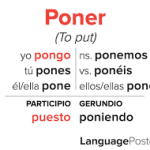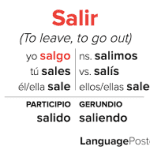Are you struggling with conjugating the verb ‘repetir’ in Spanish? Look no further!
In this article, we’ll guide you through the various tenses and forms of this verb. From the present tense to the command form, we’ve got you covered.
Whether you’re a beginner or just need a refresher, we’ll help you master conjugating ‘repetir’ in no time.
So let’s dive in and start improving your Spanish skills!
Present Tense Conjugation
To conjugate ‘repetir’ in the present tense, use the possessive noun ‘tu’ and say ‘repites’. Repetir is a regular -ir verb, so the conjugation follows a predictable pattern.
When you want to say ‘you repeat’ in Spanish, you simply use the word ‘repites’. For example, if you want to say ‘Do you repeat the words?’ in Spanish, you’d say ‘¿Repites las palabras?’.
It’s important to note that when conjugating ‘repetir’ in the present tense, you only need to change the ending of the verb. The stem remains the same. So, whether you’re talking about repeating an action or asking someone if they repeat something, remember to use ‘repites’ when addressing ‘tu’.
Preterite Tense Conjugation
Now let’s talk about the preterite tense conjugation of ‘repetir’ in Spanish.
In this tense, you’ll encounter both regular and irregular verbs.
Understanding the conjugation patterns for regular verbs and memorizing the irregular forms will help you accurately express past actions involving ‘repetir’.
Regular Vs. Irregular Verbs
Understand the difference between regular and irregular verbs in the preterite tense conjugation. Regular verbs follow a predictable pattern when conjugated, while irregular verbs have unique conjugations that don’t follow a specific pattern.
Regular verbs in the preterite tense are formed by adding specific endings to the verb stem. For example, in the regular verb ‘hablar’ (to speak), the stem remains the same (‘habl-‘) and endings such as ‘-é’, ‘-aste’, ‘-ó’ are added for different subject pronouns.
On the other hand, irregular verbs have different conjugations for each subject pronoun in the preterite tense, and their stems may change as well. Some examples of irregular verbs in the preterite tense include ‘ser’ (to be), ‘ir’ (to go), and ‘hacer’ (to do/make).
Understanding the distinction between regular and irregular verbs in the preterite tense conjugation is essential for mastering Spanish grammar.
Conjugation Patterns Explained
How do you conjugate the verb ‘repetir’ in the preterite tense in Spanish?
Here is a breakdown of the conjugation patterns:
- Yo repetí – I repeated
- Tú repetiste – You repeated
- Él/Ella/Usted repitió – He/She/You (formal) repeated
In the preterite tense, the verb ‘repetir’ follows the regular conjugation pattern for -ir verbs. The endings -í, -iste, and -ió are added to the stem ‘repet-‘ to form the conjugated forms. Remember to remove the -ir ending before adding the appropriate endings.
By understanding the conjugation patterns, you can confidently use ‘repetir’ in the preterite tense to talk about past actions or events.
Practice these conjugations to become more fluent in using this verb in conversations.
Imperfect Tense Conjugation
To conjugate ‘repetir’ in the imperfect tense, you repeated the stem ‘repet-‘ and added the appropriate endings.
In the imperfect tense, this verb expresses past actions that were habitual, ongoing, or repeated in the past without a specific endpoint.
To form the imperfect tense of ‘repetir’ in the second person singular (informal), you’d say ‘tú repetías’.
For example, if you wanted to say ‘You used to repeat the same mistake,’ you’d say ‘Tú repetías el mismo error.’
Remember that in the imperfect tense, the endings for regular -er verbs are -ía, -ías, -ía, -íamos, -íais, -ían.
Future Tense Conjugation
Now let’s move on to the future tense conjugation of ‘repetir’.
In future tense, you’ll need to pay attention to the verb endings.
To conjugate ‘repetir’ correctly, you’ll need to add the appropriate endings to the stem of the verb.
Don’t worry, we’ll also provide some practice exercises to help you master the conjugation.
Verb Endings in Future Tense
You will learn the verb endings for future tense conjugation of the verb ‘repetir’ in Spanish.
To conjugate ‘repetir’ in the future tense, follow these steps:
- Start with the infinitive form of the verb: repetir.
- Remove the -ir ending to get the stem: repet.
- Add the appropriate ending for each subject pronoun:
- Yo: repetiré (I will repeat)
- Tú: repetirás (You will repeat)
- Él/Ella/Usted: repetirá (He/She/You formal will repeat)
- Nosotros/Nosotras: repetiremos (We will repeat)
- Vosotros/Vosotras: repetiréis (You all will repeat)
- Ellos/Ellas/Ustedes: repetirán (They/You all will repeat)
Conjugating ‘Repetir’ Correctly
To correctly conjugate ‘repetir’ in the future tense, start with the stem ‘repet’ and add the appropriate endings for each subject pronoun.
For the second person singular, which is ‘you’ in English, you need to add the ending ‘-irás’ to the stem ‘repet’. This gives you the conjugated form ‘repetirás’, which translates to ‘you will repeat’.
This is used when you want to express an action that you’ll do in the future.
For example, if you want to say ‘You will repeat the lesson’, you’d say ‘Tú repetirás la lección’.
Remember to use the correct ending for each subject pronoun to ensure proper conjugation in the future tense.
Practice Exercises for Conjugation
Continuing from the previous subtopic, let’s now practice conjugating ‘repetir’ in the future tense. Here are three practice exercises to help you master this conjugation:
- Yo repetiré: This means ‘I will repeat.’ Imagine yourself confidently stating that you’ll repeat something in the future, showing your determination to learn and improve.
- Tú repetirás: This translates to ‘You will repeat.’ Picture yourself encouraging a friend to keep practicing and telling them that they’ll succeed if they continue to repeat and practice.
- Ellos repetirán: This phrase means ‘They will repeat.’ Visualize a group of people who are committed to their goal and are willing to put in the effort to repeat and perfect their skills.
Conditional Tense Conjugation
When conjugating ‘repetir’ in Spanish in the conditional tense, you’d use the double preposition ‘te lo’ to form the second person singular pronoun contraction ‘te lo repetirías’. This contraction combines the pronoun ‘te’ (you) with the direct object pronoun ‘lo’ (it) to create a single word.
So instead of saying ‘tu lo repetirías’ (you would repeat it), you’d say ‘te lo repetirías’. This contraction is used when referring to a specific thing or action that you’d repeat.
For example, if someone asks you if you’d repeat the same mistake, you could respond with ‘te lo repetirías’, meaning ‘you would repeat it’.
This contraction is commonly used in everyday conversations in Spanish and is an essential part of mastering the conditional tense conjugation of ‘repetir’.
Present Subjunctive Conjugation
To conjugate ‘repetir’ in the present subjunctive tense, you’d use the contraction ‘repitas’ when addressing someone informally. When using this conjugation, it’s important to remember that the present subjunctive is used to express desires, wishes, doubts, or possibilities.
Here are three examples to help you understand how to use ‘repitas’ in a sentence:
- Espero que repitas la receta para que todos podamos disfrutar de tu deliciosa comida. (I hope you repeat the recipe so that we can all enjoy your delicious food.)
- Ojalá que repitas el éxito que tuviste la última vez en el escenario. (I hope you repeat the success you’d last time on stage.)
- Te recomiendo que repitas la lección varias veces para que puedas entenderla completamente. (I recommend that you repeat the lesson several times so that you can fully understand it.)
Imperfect Subjunctive Conjugation
To conjugate ‘repetir’ in the imperfect subjunctive tense, you’d use the contraction ‘repetieras’ when addressing someone informally.
The imperfect subjunctive is used to express hypothetical or uncertain actions in the past.
It’s formed by taking the third person plural preterite form of the verb and replacing the ending with the appropriate subjunctive ending.
For ‘repetir’, the third person plural preterite form is ‘repitieron’.
To form the imperfect subjunctive, replace the ‘ieron’ ending with ‘ieras’.
For example, if you wanted to say ‘I hoped you repeated the lesson’, you’d say ‘Yo esperaba que tú repitieras la lección’.
It’s important to note that the imperfect subjunctive is commonly used in conjunction with the conditional tense to express hypothetical or unreal actions in the past.
Command Form Conjugation
To conjugate ‘repetir’ in the command form, use the contraction ‘repite’ when addressing someone informally. Here’s a breakdown of how to form command conjugations with ‘repetir’:
- Affirmative Informal Command (‘tú’ form): Use the second person singular form of the present indicative without the pronoun ‘tú’. For example, ‘repite’ means ‘repeat’.
- Negative Informal Command (‘tú’ form): Start with the second person singular form of the present subjunctive, and then add ‘no’ before the verb. For example, ‘no repitas’ means ‘don’t repeat’.
- Affirmative Formal Command (‘usted’ form): Use the third person singular form of the present subjunctive. For example, ‘repita’ means ‘repeat’ (formal).
Remember to use the appropriate command form depending on the level of formality and familiarity with the person you’re addressing.
Common Expressions With ‘Repetir
Now let’s explore some common expressions with ‘repetir’ to further enhance your understanding.
One common expression is ‘repetir después de mí,’ which means ‘repeat after me.’ This phrase is often used when teaching someone new words or phrases in Spanish.
Another expression is ‘no repetiré el mismo error,’ which translates to ‘I won’t repeat the same mistake.’ This phrase is used to express the idea of learning from one’s mistakes and not making them again.
Additionally, you may come across the expression ‘repetir la misma historia,’ which means ‘to repeat the same story.’ This expression is used when someone is continuously retelling a story or recounting the same events.
Frequently Asked Questions
What Is the Meaning of ‘Repetir’ in English?
Repetir means “to repeat” in English. It’s a verb that you use when you want to do something again or if you want someone else to do it again.
Are There Any Irregular Conjugations of ‘Repetir’ in Any of the Tenses?
In Spanish, ‘repetir’ is a regular verb in most tenses. However, there are a few irregular conjugations in certain tenses. Let me explain those to you.
Can ‘Repetir’ Be Used Reflexively?
Yes, ‘repetir’ can be used reflexively in Spanish. When you want to say “repeat yourself” or “repeat each other,” you can use the reflexive form of ‘repetir’ which is ‘repetirse’.
Are There Any Other Verbs That Are Similar in Meaning to ‘Repetir’?
There are other verbs in Spanish that have a similar meaning to ‘repetir’. Some examples include ‘volver a hacer’ and ‘hacer de nuevo’. These verbs also convey the idea of doing something again.
How Is the Verb ‘Repetir’ Used in the Context of Formal or Informal Speech?
To use the verb ‘repetir’ in formal or informal speech, you need to conjugate it correctly. In formal speech, use ‘repite’ for ‘you repeat.’ In informal speech, use ‘repites.’
Conclusion
In conclusion, conjugating the verb ‘repetir’ in Spanish involves various tenses and forms. It’s important to learn and practice each conjugation to effectively communicate in Spanish.
From the present tense to the conditional tense, the different conjugations of ‘repetir’ allow us to express repetition, habit, and desire.
By mastering these conjugations, we can confidently use ‘repetir’ in various contexts and conversations.


